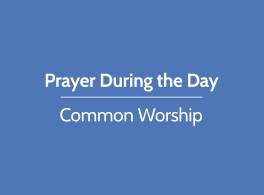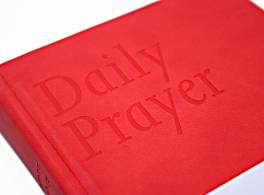¶ General Introduction ↑
The patterns of daily prayer in this volume embrace the three key elements of praise, intercession and engagement with Scripture which form the heart of the daily praying tradition of the Church. It is a praying tradition that ranges from the Daily Office – celebrated as Christians gather together, perhaps with symbol, movement and song – to other styles of daily prayer, where individuals reflect on the Scriptures with or without the help of set forms of prayer, but often using a common scheme of Bible reading.
Prayer During the Day, Morning and Evening Prayer and Night Prayer provide ways of punctuating each day of the week with praise, prayer and attention to Scripture. Thus, as George Herbert put it, ‘seven whole days, not one in seven’ will we praise God, pray for God’s world and allow ourselves to be formed and re-formed by God’s word. This introduction is intended to help each person or group to make the most suitable and satisfying use of this provision. It is followed by some general notes and seasonal notes relevant to all the orders of prayer. More detailed guidance is provided in the introduction and the accompanying notes to Prayer During the Day, Morning and Evening Prayer and Night Prayer.
Where to Start
A regular pattern
Whether Common Worship: Daily Prayer is used by an individual, a small group, a parish at prayer or a religious community, the first decision to make is what the regular pattern of worship is to be. What is chosen will depend on a number of circumstances, including the time available. One of the following patterns may be worth considering:
¶ Simply using Prayer During the Day, perhaps balancing this with Night Prayer.
¶ Following the fuller diet of Morning and/or Evening Prayer.
¶ Using both Morning Prayer and Evening Prayer with Night Prayer.
¶ Celebrating a four-fold Office of Morning Prayer, Prayer During the Day in the form of Midday Prayer, Evening Prayer and Night Prayer.
Some will also be taking part in a daily celebration of the Holy Communion.
Penitence
There is also a decision to be made about whether or when to use one of the Forms of Penitence here. This may depend on whether Holy Communion or Night Prayer, both of which usually include prayers of penitence, are being celebrated that day.
Optional material and choices
Further judgements will be needed about how much of the optional material in each order will be appropriate and which, if any, of the various alternative texts will be used. Choices will also be influenced by the way in which those who use this book decide to listen to God through Scripture in their daily prayer. It is advisable, once choices have been made, to use them consistently for at least four weeks before any change is made.
What to Read
Common Worship: Daily Prayer is designed to be used with the Common Worship lectionaries. The annual lectionary booklet, which will need to be at hand, provides two tracks of readings suitable for the office, each with an Old Testament and a New Testament reading. Here are some questions that might be asked in deciding what to read:
How many readings might be read each day?
¶ Those who are praying twice a day, morning and evening, may simply follow both tracks in the lectionary booklet, a total of four readings a day.
¶ Those who pray only once a day may use just one of the tracks.
¶ Those who wish to concentrate on one biblical book at a time may follow just one of the readings from one of the tracks for a period, alternating between New Testament and Old Testament readings to retain a balance.
Can those who pray more than once a day create a varied pattern of prayer, praise and Bible reading?
¶ Many people will use the Common Worship weekday lectionary at Morning and Evening Prayer, for which it is primarily designed. Prayer During the Day can then be a simple act of praise and prayer, possibly in the form of Midday Prayer.
¶ Others may want to use Prayer During the Day as their opportunity for sustained engagement with Scripture and will concentrate their reading of Scripture there, thus freeing Morning or Evening Prayer to focus more on praise and intercession. In this case, the Common Worship weekday lectionary may be used at Prayer During the Day, whilst the short reading set for Prayer During the Day may be used within Morning or Evening Prayer.
There are many possible combinations. The important thing is to make responsible decisions about the use of Scripture that allow for reflection on God’s word, and for the offering of praise to God and prayer for God’s world in a balanced way during the day and week.
Choosing the Psalmody
The Common Worship weekday lectionary provides psalm cycles designed to be followed at Morning and Evening Prayer.
Three shorter psalm cycles are provided in this book, all of which are intended primarily to be used with Prayer During the Day.
¶ Two tables making use of Psalm 119 and the Psalms of Ascent (Psalms 121–131 and 133) on a weekly, fortnightly or monthly pattern (here).
¶ A monthly psalm cycle for ordinary time (found within the daily orders for Prayer During the Day).
¶ A weekly psalm cycle for the seasons (found within the seasonal orders for Prayer During the Day).
If a pattern of Prayer During the Day, Morning and Evening Prayer is followed, it is recommended that the first of the above schemes for Prayer During the Day is followed, since there will be less likelihood of repetition in the psalmody.
¶ As with the Bible readings, the psalmody may be swapped between services, in a regular pattern. If several offices are said during the day and a more substantial diet of praise and psalmody is required at Midday Prayer, part of the Psalm provision in the Common Worship weekday lectionary may be used at Prayer During the Day, whilst one of the shorter Prayer During the Day cycles may be used at Morning or Evening Prayer.
¶ Suggested psalmody for Night Prayer is found within the order for Night Prayer itself and on the pages of daily and seasonal variations (here).
Where to Look in Daily Prayer
¶ The Contents pages indicate where each order of prayer can be found.
¶ It will also be necessary to know the time of the Christian year. This can be found out from the Seasonal Notes here (or from the annual lectionary booklet).
¶ In Ordinary Time (see here), there is a separate order for each day of the week for Prayer During the Day, Morning and Evening Prayer. There is also daily provision for Night Prayer (on here).
¶ For each liturgical season, there is a separate order for Prayer During the Day, Morning and Evening Prayer. There is also seasonal provision for Night Prayer (on here).
¶ The Collects and suggested canticles and refrains for Ordinary Time, for the seasons and for Holy Days may be found here. The Holy Days are set out in the Calendar (here).
¶ The General Notes (here) should also be consulted.
Setting the Scene
Attention to the place of prayer is important for those who are praying with others as much as for those who are praying by themselves.
¶ A group may find it helpful to sit in a semi-circle in an appropriately sized space, around a lectern on which the Bible is placed, rather than behind each other in pews in the main body of the church. An individual might sit regularly in a particular place, before an open Bible.
¶ Another focus may be found helpful, in addition to or occasionally in place of the lectern or Bible, such as a cross, a candle, an icon, a symbol of the season or some other Christian symbol.
¶ Other locations (e.g. around the font for the Thanksgiving for Holy Baptism here) may be suitable on different occasions, or during particular seasons.
¶ For those praying alone, anything that helps to give a sense of sharing in the prayer of the whole Church is to be welcomed.
Deciding How
The way in which these orders are celebrated helps or hinders the prayer of the worshipping group. Here are some well-tried suggestions:
¶ It is good to involve a number of people in leading and participating: reading from the Bible, for example, reading or leading the psalmody, or contributing biddings at the Prayers of Intercession.
¶ Singing, however simply, and even on one’s own, helps to deepen the worship. Singing can also unite a group or congregation, enriching their prayer and praise.
¶ A gentle and regular pace will also help to achieve this unity and focus the worship on God.
¶ Silence is not only an essential element of prayer and reflection, but also an effective way of binding the community together. It may be used at various points in any of the orders of prayer.
¶ Body posture is important, too. Even those who are praying alone will find that appropriate variation of position makes a positive difference.
¶ All of the orders lend themselves to the use of symbols and simple actions. A rough wooden cross in Passiontide, the Paschal Candle during Easter, icons of saints from All Saints’ Day until Advent are some seasonal ideas. The lighting of candles at appropriate points in the Forms of Penitence (here) and, of course, during the Blessing of Light (here), followed perhaps by the burning of incense in a censer or a simple pot during the singing of Psalm 141, are obvious and natural ways of expressing the liturgical words in action.
Decisions about singing, silence, symbol and the leading of the order of prayer should be made in advance, together with other necessary preparations. This ensures that worship can be offered by a well-prepared and confident praying community.
How to Recite
Whether singing or speaking, there are different ways of treating psalms and canticles.
¶ Some of the psalms, such as the more personal and penitential ones, are perhaps best spoken by a single voice. Everyone is encouraged to join in saying ‘Glory to the Father …’ at the end.
¶ Other psalms may be recited alternately (different individuals or groups taking alternate verses) or responsorially (using the refrain provided for the psalm – see here) at the beginning, end and whenever the symbol [R] appears.
¶ Certain psalms are best recited corporately; this is particularly appropriate for the opening canticles.
¶ The other canticles also have a refrain (sometimes called an antiphon) which is provided to set the tone. The antiphon both gives an indication of the daily or seasonal emphasis and provides text for an easily memorized musical response. It is usually used at the beginning and end of a canticle but, if this refrain is all that the people say or sing, it may be repeated regularly throughout the canticle.
¶ Even when praying alone, individuals may find that their act of praise and prayer is transformed by reading aloud.
Being Part of
a Wider Community of Prayer
Finally, although these are flexible orders of prayer that can be used in different ways according to the needs of particular praying people and communities, they will also, through common structures, texts and patterns of Scripture reading, unite those using them into one larger community of prayer. This community extends to all of those who, through the ages and across the nations, have sought to do as Jesus taught us and pray together for the hallowing of God’s name and the coming of God’s kingdom.
Common Worship: Daily Prayer, material from which is included here,
is copyright © The Archbishops' Council 2005 and published by Church House Publishing.


